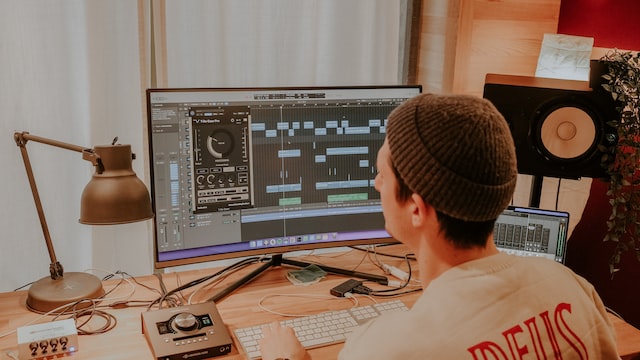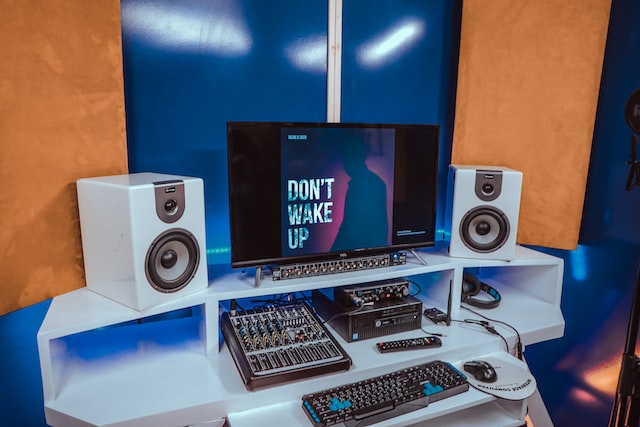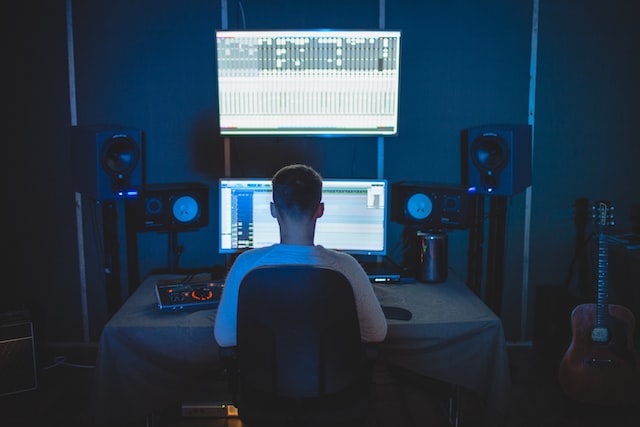
BecomeSingers is reader-supported. When you buy through links on our site, we may earn an affiliate commission. Learn More
Connecting an audio interface to your computer seems simple, but you can face several issues if you’re not doing it right: awful sound quality, glitchy audio, buzzing interference, and sometimes it might even disconnect in the middle of recording and destroy a great take.
I’ve faced these problems before when I was starting out, so I compiled a step-by-step guide to seamlessly connect your audio interface to your computer. Plus, I’ve added a few tips to get the best sound quality possible, so you can record amazing vocals and instrumentals.
Table of Contents
How Do You Connect Audio Interface to Computer?
You can connect your audio interface to your computer by using the supplied cable (USB, Thunderbolt, etc.). Then, install the drivers for your operating system from the manufacturer’s website. Open a DAW, configure the interface settings, and test it by connecting a microphone or instrument to the interface’s main input.
But if you’re still facing some problems, here’s a step-by-step guide to show you exactly how to do it, along with some tips to get the best sound quality.
Equipment Needed while Connecting Audio Interface to Computer
- Audio Interface
- Desktop/Laptop (both Mac and Windows work)
- A compatible cable (USB, Thunderbolt, or FireWire)
- DAW (such as Ableton, FL Studio, Reaper, etc.)
- Microphone/Instrument to Test
- Studio Monitors (or Headphones)
Connecting Audio Interface to Computer: A Step-by-step Breakdown

1. Connect Your Audio Interface With A Cable
In most cases, your audio interface comes with a compatible cable in the box. This varies based on model and manufacturer, but the common cables are USB Type-C, Type-B, Thunderbolt, and FireWire (only on some old models). If you purchased a recent model, most likely, it’ll work on USB Type-C.
If it didn’t come with a cable, check your manufacturer’s website to see the specifications for their recommended cable. You’ll have to order this from Amazon or somewhere.
Once you have a cable, just plug it into your interface, and plug the other end into your computer. If necessary, you can use an adapter (such as Type-A to Type-C), but make sure it’s high-quality and preferably gold-plated to avoid any connection interference.
2. Setup The Audio Interface With Drivers
On macOS, your audio interface will likely automatically download the best drivers and install them, so you should be good to go. Drivers are key to make your audio interface work well.
But on Windows, you’ll have to visit the manufacturer’s website, find your model, download the recommended drivers, and install them yourself. Also, you’ll have to repeat this process from time to time to make sure you always have the latest drivers.
Sometimes, manufacturers may include CDs or direct download links to speed up the process. But going to the website and registering your model is recommended as it helps with any support or warranty claims in the future.
3. Install A DAW Of Your Choice
If you already have worked with DAWs (Digital Audio Workstations) before, then this should be easy. But if you don’t have a DAW installed yet, then you’ll have to download and install one.
On macOS, I recommend Garageband as it’s free and easy to get started with.
And on Windows, you may try a 60-day trial of Reaper, one of the best home studio DAWs for beginners, and an affordable one. If you want a free DAW, try Audacity, BandLab’s Cakewalk, or Waveform.
Also, sometimes your audio interface comes included with subscriptions to a DAW, plus some other freebies and music goodies. Always check what’s available when registering your product, as this can give you a good headstart.
4. Open Your DAW And Configure The Interface
Now, open the DAW you just installed. It should show a pop-up with the audio device settings; if not, just go to settings and look for ‘Audio Device’.
Here, you’ll have to select the appropriate driver; most interfaces use ASIO or a variant of it, so you’ll likely see that in the drop-down list. Select the driver, then select the device (your interface’s name), and then you’ll see some more options:
- Inputs: Select and enable all available inputs you see.
- Outputs: Select all available outputs, or you may select only the ones you’re using (usually it’s 1-2)
- Sample Rate: I recommend 44.1kHz as it’s the standard for recording, but you can also go for 48kHz if you prefer. Only go for higher sample rates like 88.2 or 96kHz if you have a really powerful computer that can handle it.
- Buffer Size: This is the most important setting and it depends on your purpose and computer. Lower buffer size = lower latency, but higher CPU usage. A buffer size of 128 samples is good to start with, but if you face any crackling or glitchy noises, increase it to 256. Beyond that, you may face too much latency to record smoothly, and a more powerful computer is recommended.
If you see any other settings, you can likely leave them on default for now. This can vary from DAW to DAW, as well as the interface. Only change them if you’ve gone through the manual and know what each one does.
5. Connect Your Mic Or Instrument To The Interface
It’s time to connect your microphone (or instrument, such as a guitar) to the main input of the interface so that you can test it.
For microphones, you’ll probably already have an XLR cable, so connect that to Input 1 of your interface. For guitars: if your interface has a dedicated guitar input, use that. Otherwise, use Input 1 using a guitar cable (TS or TRS).
Now you have to set the gain properly; some audio interfaces do have automatic gain functions that you can use. For this, try singing (or playing your guitar) at your highest volume, and slowly increase the gain. Once the indicator shows red (for clipping), decrease it just a little bit.
The signal should be strong and steady, but never clip. If at any point your interface’s gain indicator shows a red sign, just decrease the knob a little bit. And if you feel your signal is breaking or not powerful enough, increase it. But always make adjustments in small steps for precision.
Also, if you haven’t already, make sure you’ve connected a pair of studio monitors or headphones to your audio interface so you can clearly listen to what you sing or play.
6. Test Your Audio Interface
Now that you’ve connected and set up all your equipment, it’s time to test if everything is working correctly. First, make sure that the volume knob on your interface is set to a low-medium level to avoid excessively loud music.

Fire up your DAW and create some empty tracks. Assign the inputs to your microphone or instrument based on how you connected them. Turn ‘Record Monitoring’ ON, as it’ll help you hear your sound through your studio monitors or headphones as you record.
Now, just hit ‘Record’ and test it! You should be able to hear everything crisply and clearly, with zero audio crackles, glitches, buzzing, interference, dropouts, or anything that seems unusual to you.
You can also test your output just by playing audio on your computer, such as some video on YouTube or a song on Spotify. And adjust the volume knob (also called the monitoring knob) till it’s at a comfortable level for you and just loud enough for clarity.
Tips For Audio Problems And Optimizing Quality
If you’re still facing any issues with your audio, you should try these tips:
- Drivers: Always make sure you have the latest drivers installed.
- Buffer Size: Try a lower/higher buffer size, as a different one may work smoothly.
- Sample Rate: Try switching to a different sample rate and then back to the original one. This ‘soft resets’ the device and often clears any issues.
And if these don’t help, try disconnecting the device, rebooting your computer, and connecting it only after your OS is fully booted up.
FAQs
What is the best connection for an audio interface?
Do audio interfaces connect via USB?
What is the purpose of a USB audio interface?
Conclusion
Connecting an audio interface to your computer is pretty easy once you get the basics. And if you do it right by following each step, you likely won’t face any problems. Plus, you’ll get minimal latency and the best sound quality by setting the right audio device settings in your DAW. Just press record, and let your musical ideas flow!
I hope you found this article helpful and were able to solve your audio interface connectivity issues. If you liked this article, share it with your friends, and if you have any queries, feel free to contact us!





